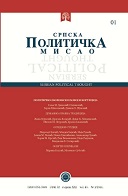КОРУПЦИЈА У ЕВРОПСКОЈ УНИЈИ
CORRUPTION IN THE EUROPEAN UNION
Author(s): Zoran MiloševićSubject(s): Politics / Political Sciences
Published by: Институт за политичке студије
Keywords: Corruption; deliberately inefficient management; European Union; democracy; integration; political correctness
Summary/Abstract: In public opinion survey in the EU since 2009, from 75 to 79 percent of the respondents believe that the main problem of the EU is not an economic crisis and unemployment, but corruption. According to the latest survey of “Eurobarometar” from the 2012, 74 percent of EU citizens perceived the growth of corruption. But, especially discouraging is the attitude of the majority of citizens of the Union that victory over corruption is not possible (70 percent), and 67 percent of Europeans believe that corruption is part of the business and culture of each country. Because it is not rare that the authors conclude: “It is safe to determine that today’s corruption is a global phenomenon and one of the biggest problems of our time and modern society in general”. Respondents are, among the corrupt professionals in EU, beside politicians appointed police (30 percent of respondents said they had paid a bribe), state clerks (one-fifth of respondents stated that they gave a bribe to get the decisions or solutions), judges (14 percent), followed by physicians and market inspectors. Corruption as a concept and as a practice occurs only in the second half of the XX century, exactly with the development of de mocracy after World War II. In this period corporations, especially on the West, began corruption process of state clerks, but entry in the globalization era, this social harmful phenomenon affects negatively on the development many countries and nations. In the opinion of some authors, corruption is “normal activity in capitalism”, from which it is possible deliverance only “with breakdown of the system”, because as time passes, corruption is only increasing.
Journal: Српска политичка мисао
- Issue Year: 2014
- Issue No: 1
- Page Range: 29-42
- Page Count: 14

